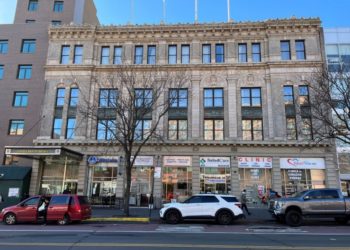
The Bronx Opera House building. Image Credit: LPC.
On February 14, 2023, the Landmarks Preservation Commission voted to calendar the Bronx Opera House for consideration as an individual landmark. The Bronx Opera House is located at 436-442 East 149th Street in the South Bronx.
The Bronx Opera House is a four-story building built in the Italian Renaissance Revival style from 1912 to 1913 by architect Geroge Keister. Keister designed buildings across Manhattan and the Bronx, including the Apollo Theater and Belasco’s Stuyvesant Theater. The building features a tripartite facade with classic ornaments, articulated fluted pilasters and carved tympanums, the carved semi-circles over the middle windows. The developer, George M. Cohan was an actor, playwright, composter, producer, dancer, and songwriter. His work includes musical numbers “Yankee Doodle Dandy” and “Give My Regards to Broadway.” He opened several theaters in the first two decades of the 1900s.
The Bronx Opera House first served as part of the “Subway Circuit,” or a theater where Broadway productions could be tested in outer boroughs before going on regional or nationwide tours. After World War II, the Bronx Opera House became home to several nightclubs following a migration of tens of thousands of Puerto Ricans to New York City. The nightclubs included the Club Caravana, El Cerromar and the Bronx Casino. Performers Tito Rodriguez, Charlie Palmieri and Johnny Pacheco were among the many who performed at the nightclubs at the Bronx Opera House. In 1961, Palmieri recorded an album entitled “Pachanga at Club Caravana” in the building with his brother Eddie Palmieri. The building remained a prominent nightlife location for decades and served as a community place for social gathering and the expression of Latino culture.
The building was purchased by a Pentecostal church in the 1980s. The auditorium at the back of the building was demolished in 2011. The building was redesigned and opened as the Opera House Hotel in 2013. The historic portion of the building that contains the lobby and original restaurant space still remains. As a result of the demolished auditorium, only the portion of the site that faces East 149th Street and contains the historic portion of the building will be considered for designation. The remainder of the lot is excluded.
According to Landmarks staff, the Bronx Opera House was identified as a potential landmark as part of a comprehensive study of the Bronx and through efforts to identify locations that are significant to Latino history and culture.
Landmarks voted unanimously to calendar the Bronx Opera House for consideration and will hold a public hearing at a later date.
By: Veronica Rose (Veronica is the CityLaw fellow and a New York Law School graduate, Class of 2018.)

